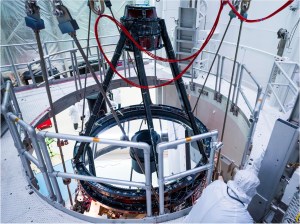Primary Instrument for Roman Space Telescope Arrives at NASA Goddard
The primary instrument for NASA’s Nancy Grace Roman Space Telescope is a sophisticated camera that will survey the cosmos from the outskirts of our solar system all the way out to the edge of the observable universe. Called the Wide Field Instrument, it was recently delivered to the agency’s Goddard Space Flight Center in Greenbelt, […]

The primary instrument for NASA’s Nancy Grace Roman Space Telescope is a sophisticated camera that will survey the cosmos from the outskirts of our solar system all the way out to the edge of the observable universe. Called the Wide Field Instrument, it was recently delivered to the agency’s Goddard Space Flight Center in Greenbelt, Maryland.
The camera’s large field of view, sharp resolution, and sensitivity from visible to near-infrared wavelengths will give Roman a deep, panoramic view of the universe. Scanning much larger portions of the sky than astronomers can with NASA’s Hubble or James Webb space telescopes will open new avenues of cosmic exploration. Roman is designed to study dark energy (a mysterious cosmic pressure thought to accelerate the universe’s expansion), dark matter (invisible matter seen only via its gravitational influence), and exoplanets (worlds beyond our solar system).
“This instrument will turn signals from space into a new understanding of how our universe works,” said Julie McEnery, the Roman senior project scientist at Goddard. “To achieve its main goals, the mission will precisely measure hundreds of millions of galaxies. That’s quite a dataset for all kinds of researchers to pull from, so there will be a flood of results on a vast array of science.”
About 1,000 people contributed to the Wide Field Instrument’s development, from the initial design phase to assembling it from around a million individual components. The WFI’s design was a collaborative effort between Goddard and BAE Systems in Boulder, Colorado. Teledyne Imaging Sensors, Hawaii Aerospace Corporation, Applied Aerospace Structures Corporation, Northrop Grumman, Honeybee Robotics, CDA Intercorp, Alluxa, and JenOptik provided critical components. Those parts and many more, made by other vendors, were delivered to Goddard and BAE Systems, where they were assembled and tested prior to the instrument’s delivery to Goddard this month.
“I am so happy to be delivering this amazing instrument,” said Mary Walker, Roman’s Wide Field Instrument manager at Goddard. “All the years of hard work and the team’s dedication have brought us to this exciting moment.”
NASA’s Goddard Space Flight Center
Seeing the Bigger Picture
After Roman launches by May 2027, each of the Wide Field Instrument’s 300-million-pixel images will capture a patch of the sky bigger than the apparent size of a full moon. The instrument’s large field of view will enable sweeping celestial surveys, revealing billions of cosmic objects across vast stretches of time and space. Astronomers will conduct research that could take hundreds of years using other telescopes.
And by observing from space, Roman’s camera will be very sensitive to infrared light –– light with longer wavelengths than our eyes can see –– from far across the cosmos. This ancient cosmic light will help scientists address some of the biggest cosmic mysteries, one of which is how the universe evolved to its present state.
From the telescope, light’s path through the instrument begins by passing through one of several optical elements in a large wheel. These elements include filters, which allow specific wavelengths of light to pass through, and a grism and prism, which split light into all of its individual colors. These detailed patterns, called spectra, reveal information about the object that emitted the light.
Then, the light travels on toward the camera’s set of 18 detectors, which each contain 16 million pixels. The large number of detectors and pixels gives Roman its large field of view. The instrument is designed for accurate, stable images and exquisite precision in measuring the exact amount of light in every pixel of every image, giving Roman unprecedented power to study dark energy. The detectors will be held at about minus 300 degrees Fahrenheit (minus 184 degrees Celsius) to increase sensitivity to the infrared universe.
“When the light reaches the detectors, that marks the end of what may have been a 10-billion-year journey through space,” said Art Whipple, an aerospace engineer at Goddard who has contributed to the Wide Field Instrument’s design and construction for more than a decade.
Once Roman begins observing, its rapid data delivery will require new analysis techniques.
“If we had every astronomer on Earth working on Roman data, there still wouldn’t be nearly enough people to go through it all,” McEnery said. “We’re looking at modern techniques like machine learning and artificial intelligence to help sift through Roman’s observations and find where the most exciting things are.”
Now that the Wide Field Instrument is at Goddard, it will be tested to ensure everything is operating as expected. It will be integrated onto the instrument carrier and mated to the telescope this fall, bringing scientists one step closer to making groundbreaking discoveries for decades to come.
To virtually tour an interactive version of the telescope, visit:
https://roman.gsfc.nasa.gov/interactive
The Nancy Grace Roman Space Telescope is managed at NASA’s Goddard Space Flight Center in Greenbelt, Maryland, with participation by NASA’s Jet Propulsion Laboratory and Caltech/IPAC in Southern California, the Space Telescope Science Institute in Baltimore, and a science team comprising scientists from various research institutions. The primary industrial partners are BAE Systems, Inc. in Boulder, Colorado; L3Harris Technologies in Rochester, New York; and Teledyne Scientific & Imaging in Thousand Oaks, California.
By Ashley Balzer
NASA’s Goddard Space Flight Center, Greenbelt, Md.
Media contact:
Claire Andreoli
claire.andreoli@nasa.gov
NASA’s Goddard Space Flight Center, Greenbelt, Md.
301-286-1940
Share
Details
Related Terms
What's Your Reaction?



















.jpg?#)




































